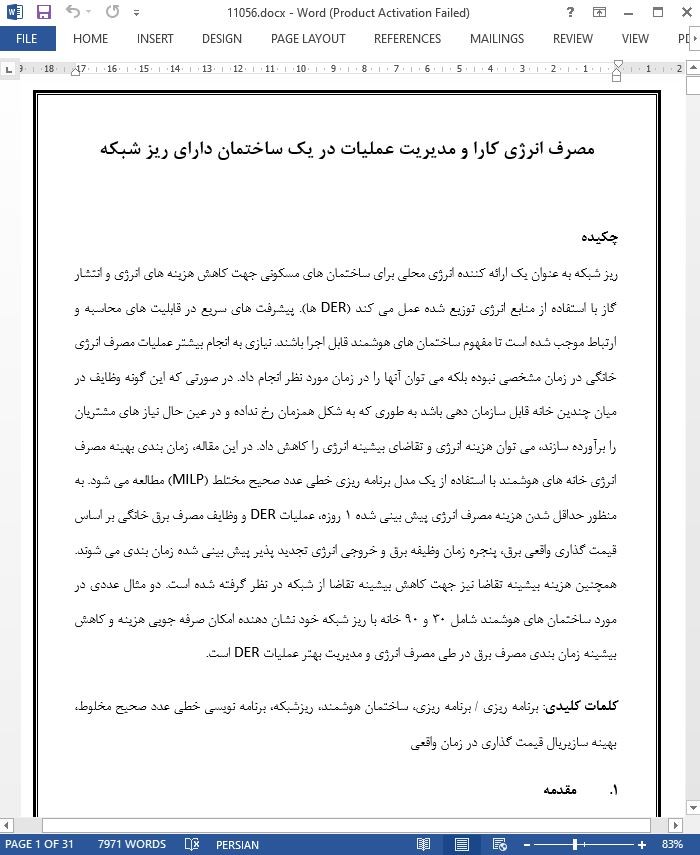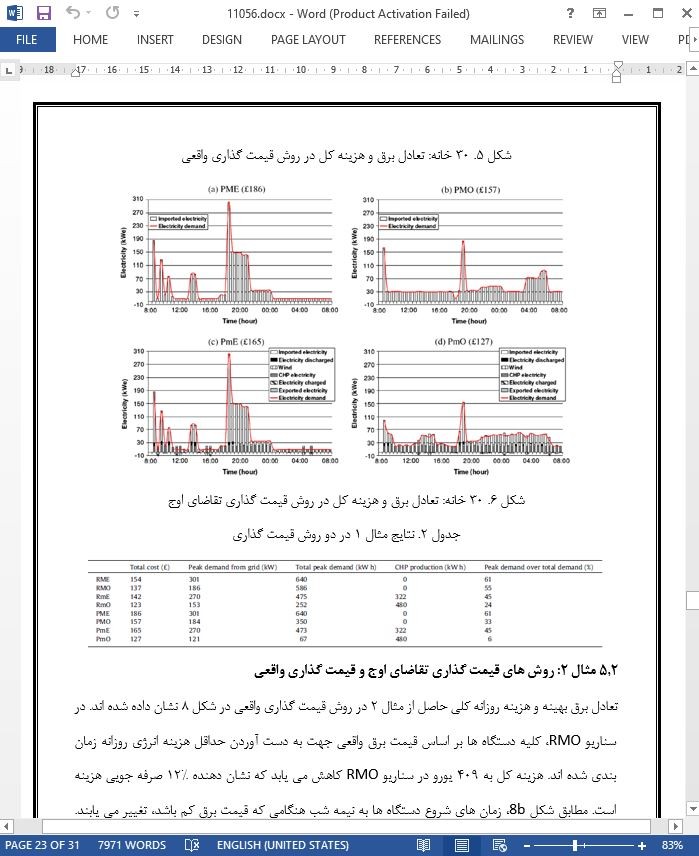
مصرف انرژی کارا و مدیریت عملیات در یک ساختمان دارای ریز شبکه
چکیده
ریز شبکه به عنوان یک ارائه کننده انرژی محلی برای ساختمان های مسکونی جهت کاهش هزینه های انرژی و انتشار گاز با استفاده از منابع انرژی توزیع شده عمل می کند (DER ها). پیشرفت های سریع در قابلیت های محاسبه و ارتباط موجب شده است تا مفهوم ساختمان های هوشمند قابل اجرا باشند. نیازی به انجام بیشتر عملیات مصرف انرژی خانگی در زمان مشخصی نبوده بلکه می توان آنها را در زمان مورد نظر انجام داد. در صورتی که این گونه وظایف در میان چندین خانه قابل سازمان دهی باشد به طوری که به شکل همزمان رخ نداده و در عین حال نیاز های مشتریان را برآورده سازند، می توان هزینه انرژی و تقاضای بیشینه انرژی را کاهش داد. در این مقاله، زمان بندی بهینه مصرف انرژی خانه های هوشمند با استفاده از یک مدل برنامه ریزی خطی عدد صحیح مختلط (MILP) مطالعه می شود. به منظور حداقل شدن هزینه مصرف انرژی پیش بینی شده 1 روزه، عملیات DER و وظایف مصرف برق خانگی بر اساس قیمت گذاری واقعی برق، پنجره زمان وظیفه برق و خروجی انرژی تجدید پذیر پیش بینی شده زمان بندی می شوند. همچنین هزینه بیشینه تقاضا نیز جهت کاهش بیشینه تقاضا از شبکه در نظر گرفته شده است. دو مثال عددی در مورد ساختمان های هوشمند شامل 30 و 90 خانه با ریز شبکه خود نشان دهنده امکان صرفه جویی هزینه و کاهش بیشینه زمان بندی مصرف برق در طی مصرف انرژی و مدیریت بهتر عملیات DER است.
1. مقدمه
با توجه به افزایش تقاضای انرژی و افزایش انتشار گاز های گلخانه ای در سطح جهان، سیستم تولید متمرکز در معرض چالش قرار گرفته است. سیستم توزیع برق آینده به صورت یکپارچه و هوشمند بوده و به عنوان شبکه هوشمند شناخته می شود که شامل کنتور های پیشرفته دیجیتال، اتوماسین توزیع، سیستم های ارتباط و منابع انرژی توزیع شده است. کارکرد های مطلوب شبکه هوشمند شامل خود ترمیمی، بهینه سازی استفاده از سرمایه و کاهش عملیات ها و هزینه های نگهداری است. ریز شبکه به صورت یک شبکه انرژی موضوعی کوچک است که شامل بارها، سیستم کنترل شبکه و مجموعه ای از منابع انرژی توزیع شده (DER ها) مانند ژنراتور ها و دستگاه های ذخیره انرژی است. یک ریز شبکه می تواند در حالت شبکه متصل شده و یا جزیره ای هنگام وجود عیوب خارجی و یا ایجاد مزیت اقتصادی اجرا شود. یک ریز شبکه مجهز به عناصر هوشمند شبکه هوشمند جهت گسترش DER ها و برنامه های پاسخ تقاضا در سیستم های توزیع استفاده شده است که به عنوان شبکه هوشمند آینده در نظر گرفته می شود. ریزشبکه دارای یک رویکرد اقتصادی مقرون به صرف به دلیل عدم نیاز به خرید انرژی در طی دوره های اوج مصرف و کاهش مصرف کربن از طریق تولید کربن کم/ آلاینده کم و تولید انرژی و حرارت است که دارای کارایی انرژی بیشتری است. همچنین این رویکرد موجب ایجاد تقاضای انرژی امن و قابل اطمینان در طی دوره خاموشی به صورت یک سیستم تامین انرژی پشتیبانی است.
6. نتیجه گیری
یک مدل MILP برای مصرف انرژی و مدیریت عملیات در ساختمان هوشمند با دو خانه پیشنهاد شده است. دو مثال از 30 خانه با عادات زندگی مشابه و 90 خانه با عادات زندگی متفاوت برای یک روز زمستانی مطالعه شده اند. دوازده وسیله برقی خانگی و عملیات تجهیزات بر اساس پنجره های زمانی مشخص، قیمت های برق شبکه واقعی نیم ساعتی و شار اضافی تقاضای اوج جهت به دست آوردن حداقل هزینه و تقاضای انرژی زمان بندی شده اند. صرفه جویی قابل توجه در هزینه ها و بیشینه صرفه جویی تقاضا در هر دو مثال به دست آمده است.
Abstract
Microgrid works as a local energy provider for domestic buildings to reduce energy expenses and gas emissions by utilising distributed energy resources (DERs). The rapid advances in computing and communication capabilities enable the concept smart buildings become possible. Most energy-consuming household tasks do not need to be performed at specific times but rather within a preferred time. If these types of tasks can be coordinated among multiple homes so that they do not all occur at the same time yet still satisfy customers’ requirement, the energy cost and power peak demand could be reduced. In this paper, the optimal scheduling of smart homes’ energy consumption is studied using a mixed integer linear programming (MILP) approach. In order to minimise a 1-day forecasted energy consumption cost, DER operation and electricity-consumption household tasks are scheduled based on real-time electricity pricing, electricity task time window and forecasted renewable energy output. Peak demand charge scheme is also adopted to reduce the peak demand from grid. Two numerical examples on smart buildings of 30 homes and 90 homes with their own microgrid indicate the possibility of cost savings and electricity consumption scheduling peak reduction through the energy consumption and better management of DER operation.
1. Introduction
Due to the increase of energy demand and rising global emissions of greenhouse gases, the current centralised generation system is challenged. The future electricity distribution system will be integrated, intelligent and better known as smart grid, which includes advanced digital metres, distribution automation, communication systems and distributed energy resources. The desired smart grid functionalities include self-healing, optimising asset utilisation and minimising operations and maintenance expenses [1]. Microgrid is a relatively small-scale localised energy network, which includes loads, network control system and a set of distributed energy resources (DERs), such as generators and energy storage devices. A microgrid can operate in either grid connected or islanded mode1 when there are external faults and/or to gain economic advantage. A microgrid equipped with intelligent elements from smart grid has been adopted to enable the widespread of DERs and demand response programs in distribution systems [2], which is considered as future smart grid. Microgrid has an economic incentive due to avoiding energy purchases during peak periods and creation of carbon benefits through low-carbon/low-pollutant generation and co-production of heat and power, which has higher energy efficiency. It also provides secure and reliable energy supply during serious blackout period as a back-up energy supplying system.
6. Concluding remarks
An MILP model has been proposed for energy consumption and operation management in a smart building with multiple smart homes. Two examples of 30 homes with same living habit and 90 with different living habits for a winter day have been studied. Twelve domestic electrical tasks and equipment operations are scheduled based on given time windows, real-time half-hourly grid electricity prices and peak demand extra charge to obtain the minimum cost and energy demand. Significant cost savings and peak demand savings have been achieved in both examples.
چکیده
1. مقدمه
2. شرح مسئله
3. مدل ریاضی
3.1 محدودیت ظرفیت
3.2 محدودیت های ذخیره سازی انرژی
3.3 خروجی ژنراتور باد
3.4 تعادل انرژی
3.5 زمان شروع و پایان
3.6 شار تقاضای اوج
3.7 تابع هدف
4. مثال های توضیحی
4.1 مثال 1: ساختمان هوشمند با 30 واحد با عادات زندگی مشابه
4.2 مثال 2: ساختمان هوشمند با 90 واحد و عادات زندگی متفاوت
5 . نتایج محاسبات
5.1 مثال 1: رویکرد های قیمت واقعی و تقاضای اوج
5.2 مثال 2: روش های قیمت گذاری تقاضای اوج و قیمت گذاری واقعی
5.3 مقایسه بین مثال 1 و مثال 2
6. نتیجه گیری
Abstract
1. Introduction
2. Problem description
3. Mathematical model
3.1. Capacity constraint
3.2. Energy storage constraints
3.3. Wind generator ouput
3.4. Energy balances
3.5. Starting time and finishing time
3.6. Peak demand charge
3.7. Objective function
4. Illustrative examples
4.1. Example 1: Smart building of 30 homes with same living habits
4.2. Example 2: Smart building of 90 homes with different living habits
5. Computation results
5.1. Example 1: real-time price and peak demand price schemes
5.2. Example 2: real-time price and peak demand price schemes
5.3. Comparison between Example 1 and Example 2
6. Concluding remarks
- ترجمه فارسی مقاله با فرمت ورد (word) با قابلیت ویرایش، بدون آرم سایت ای ترجمه
- ترجمه فارسی مقاله با فرمت pdf، بدون آرم سایت ای ترجمه



